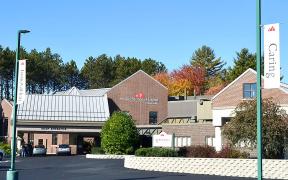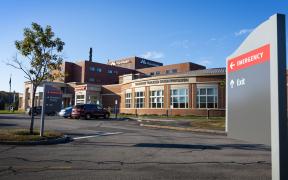What is arrhythmia?
Arrhythmias are problems in the electrical function of the heart that can cause abnormal heart rhythms (irregular heart beat). Sometimes the heart beats too slowly (bradycardia), too quickly (tachycardia), or it can simply stop (sudden cardiac death syndrome). A heart specialist called an electrophysiologist treats arrhythmias. The MaineHealth electrophysiology (EP) team has expertise in treating the full range of arrhythmias.
Arrhythmia Symptoms
- Fluttering heart beat
- Chest pain
- Fainting
- Dizziness
- Shortness of breath
MaineHealth Cardiac Arrhythmia Program
Your provider will do a complete medical evaluation to diagnose arrhythmia. They will ask about your medical history and complete a physical exam. They may order some diagnostic tests, including:
- Blood tests
- Chest x-ray
- Electrocardiogram (EKG)
- Holter monitor or event monitor (portable EKG/ECG)
- Stress test
- Echocardiogram
There are many different types of arrhythmia. The most common type is atrial fibrillation, or AFib. AFib is an irregular heart rhythm that is often very fast. People with atrial fibrillation are at higher risk of stroke.
• Atrial fibrillation (AFib)
• Atrial flutter
• Paroxysmal atrial tachycardia (PAT)
• Premature supraventricular or atrial contractions (PACs)
• Premature ventricular complexes (PVCs)
• Sick sinus syndrome
• Sinus arrhythmia
• Sinus tachycardia
• Sudden cardiac death syndrome
• Supraventricular tachycardia (SVT)
• Ventricular fibrillation
• Ventricular tachycardia
• Wolff-Parkinson-White syndrome
There are a variety of ways to treat arrhythmia, including lifestyle changes, medications, medical devices, or minimally invasive procedures to regulate the rhythm of the heart. MaineHealth offers a full array of the most advanced treatment services, provided by one of the most experienced EP teams in New England.
Medical management – Cardiac medicines, such as beta blockers, can be used to control abnormal heart rhythms. Anticoagulant medicines can be used to lower the risk of blood clots.
Device management – Patients with implanted devices must be regularly monitored. MaineHealth specialists see cardiac patients at local hospitals across Maine and parts of New Hampshire to monitor and manage their pacemakers and ICDs.
Left atrial appendage occlusion/closure (LAAC) device – This device is implanted in the left atrial appendage of the heart to permanently close off a small pouch in the heart and to keep harmful blood clots from entering the bloodstream.
Pacemaker implantation – A pacemaker is a small device, surgically implanted under the skin. It sends electrical impulses to the heart muscle to help maintain a consistent heart rate and rhythm.
Cardiac resynchronization therapy (CRT) or biventricular pacing – This special pacemaker is used to regulate the delayed heart contractions that can happen with advanced heart failure. In about 30% of patients with heart failure, an abnormality in the heart's electrical conduction system causes the heart’s two ventricles to beat out of sync, which lowers the efficiency of an already-damaged heart. CRT re-coordinates the beating of the two ventricles so they beat at the same time.
Implantable cardioverter defibrillator (ICD) placement – Also surgically implanted under the skin, an ICD is an electronic device that constantly monitors the heart’s rhythm. When it detects an abnormal heart rhythm, it delivers energy to shock the heart back into beating regularly.
Catheter ablation – The most effective treatment for some arrhythmias is to destroy the heart tissue that is causing the short circuit. This non-surgical procedure is called ablation. It is done by threading a catheter through a blood vessel and using an x-ray) to find the problem. Radiofrequency energy, delivered through the catheter, is used to burn or freeze a small amount of tissue. This helps restore a healthy heart rhythm. Catheter ablation can eliminate the need for open-heart surgery or long-term medical management in many patients.
AV node ablation – The AV node is the electrical pathway that connects the atria (upper chambers of the heart) to the ventricles (lower chambers). Interrupting this pathway with a catheter ablation procedure prevents the upper chambers of the heart from controlling the rate of the lower chambers, which determines the heart and pulse rate. This procedure can lower symptoms of atrial fibrillation (AFib). Patients who receive AV node ablation will also require a permanent pacemaker.
Cardioversion – When the heart beats too quickly, blood can no longer circulate effectively in the body. Cardioversion restores the heart's normal rhythm and efficient pumping action by applying a controlled electric shock to the exterior of the chest.
Laser lead extraction – A lead is a special wire that delivers energy from a pacemaker or ICD to the heart muscle. Extraction is needed when the leads are not working properly due to damage, the build-up of scar tissue or infection.
Open-heart surgery – This procedure, in which a number of incisions are made in the heart’s atria (upper chambers), causes scar tissue to form. The scare tissue acts as insulation and forces the heart’s electrical impulses to travel in the correct direction.
Convergent procedure – This procedure is less invasive than open-heart surgery and can be highly effective in restoring normal heart rhythm. The procedure uses radio frequency (focused heat) to create scar tissue on the heart to block abnormal electrical signals. The procedure is done on the inside and outside of the heart.
MaineHealth Cardiovascular Programs:
Aortic Disease Program
Carotid Revascularization Program
Comprehensive Vein Program
Limb Salvage Program
Rare Vascular Conditions Program
Thoracic Outlet Syndrome Program
Advanced Heart Failure Program
Cardiac Valve Program
Coronary Revascularization Program






























